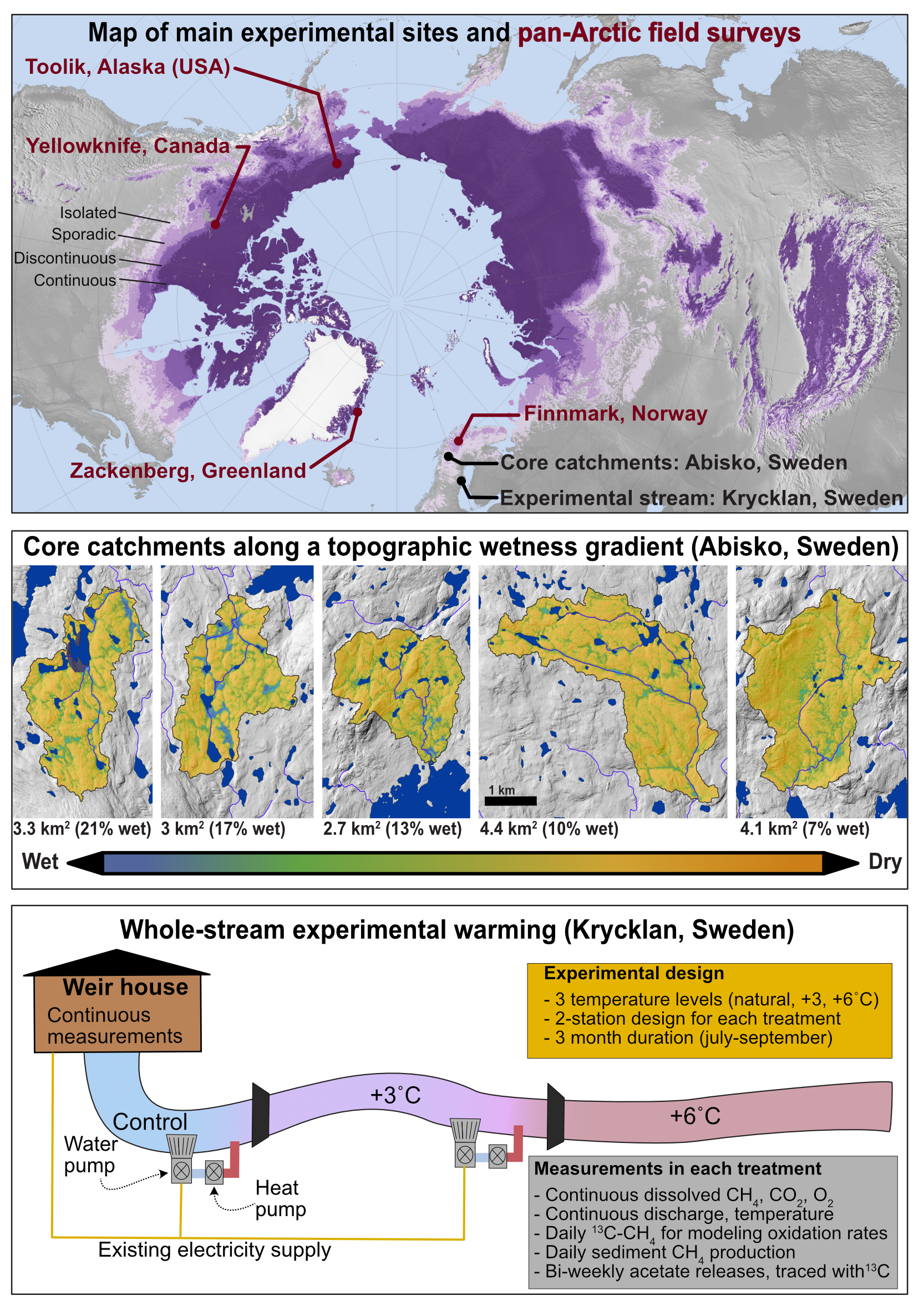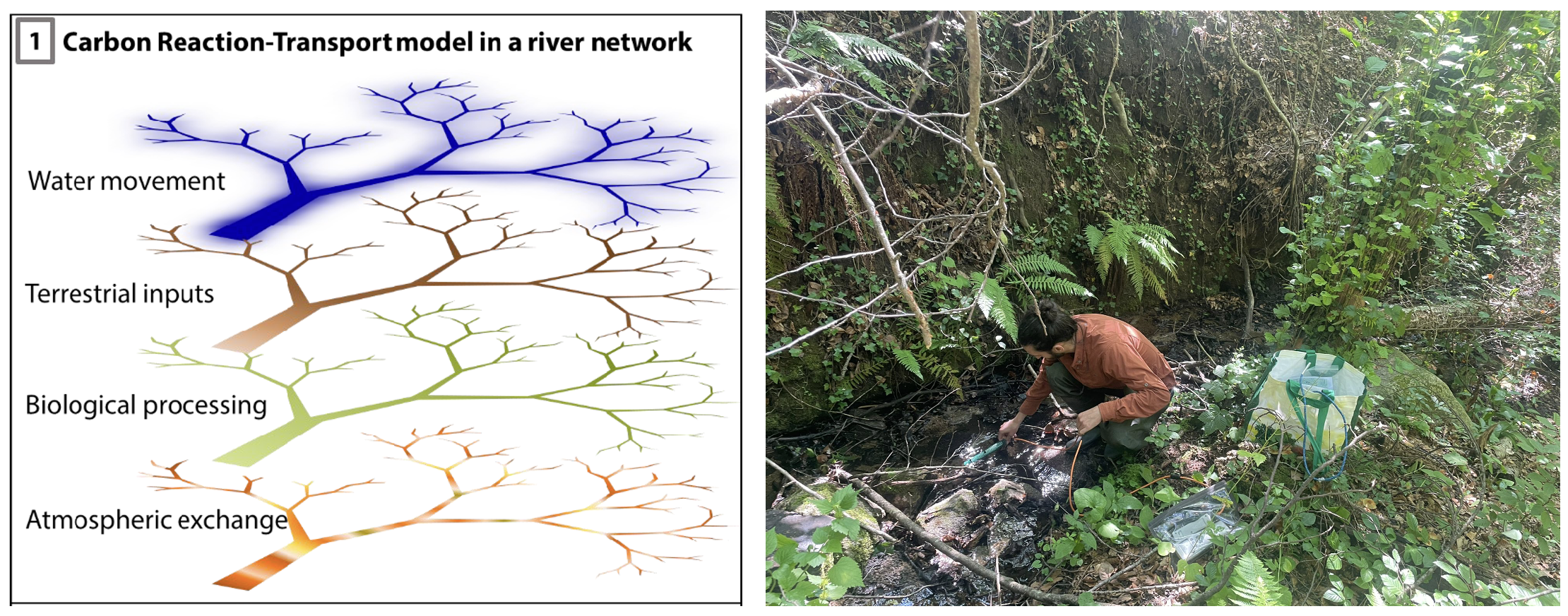Current projects
Here I have some information of ongoing projects.
ARIMETH (ERC Starting Grant): A mechanistic understanding of Arctic river methane emissions
Collaborators: Many
I just got funded an ERC Starting grant (1.9M €) to study methane emissions from Arctic rivers. The goal is to study the methane dynamics in Arctic rivers from an ecosystem ecology perspective, and develop a model to predict river methane emissions across the Arctic. There is funding for postdoc positions so you are welcome to reach out for further details.
Constraining the global methane (CH4) budget is urgently needed to predict future climate. Rivers are an important source of CH4 to the atmosphere, with surprisingly high rates of emissions in northern regions. The high emissions from Arctic rivers are driven by lateral inputs from surrounding land and are very sensitive to climate, but are also challenging to capture.
Given severe impacts of ongoing climate change at high latitudes, CH4 emissions from Arctic rivers have a strong potential to further increase. Yet, we are unable to understand and predict future river emissions because we lack process-based models that represent CH4 inputs and emissions from river ecosystems. This limitation arises from our poor understanding of river Arctic CH4 cycling in general, with a lack of mechanistic studies at local and landscapes scales that are foundational to advancing process-based models.
ARIMETH aims to address this issue, by initially generating the mechanistic understanding of Arctic riverine CH4 cycling. Subsequently, the project will develop the modelling tools to predict current and future CH4 emissions. These goals will be achieved through a comprehensive and multi-scale research program, including a whole-stream warming experiment, high-resolution measurements with state-of-the-art CH4 sensors coupled with remote sensing data, pan-Arctic sampling campaigns to identify CH4 sources using carbon radioisotopes, and finally developing deep-learning mechanistic models for river CH4 emissions.
The outcomes of ARIMETH will offer insights into river CH4 cycling, from the scale of individual rivers, to surrounding catchments, to the pan-Arctic. Finally, ARIMETH will determine if CH4 emissions from Arctic freshwaters are underestimated when lateral fluxes to rivers and emissions are not accounted for. This is critical to predict future trajectories of global warming, as well as to discover unrecognized feedbacks between the terrestrial-aquatic-atmospheric compartments in the broad carbon cycle.

A reaction-transport model for Carbon processing in stream networks across land productivity gradients
Collaborators: Susana Bernal (CEAB-CSIC, Spain), Hjalmar Laudon (SLU, Sweden)
In this project we are developing a whole-stream network transport-reaction model for carbon, that captures the inputs, transport and processing of carbon within the stream networks. The project has currently two parts, first one is to use the model to explore how multiple physical, chemical and biological processes affect the temporal patterns and coupling of O2 and CO2 in rivers. The second part consists in applying the model in space, in two fully forested catchments but with very dramatic differences in climate and in sources of organic carbon (Regàs in Spain is dominated by litter fall, Krycklan in Sweden is dominated by dissolved organic Carbon).
This project is funded by a mobility grant from the Swedish Research Council, where I have the opportunity to do a research stay in the Blanes Centre of Advanced Research (CSIC, Spain).
Timeline 2022 – 2025

Archive of some past projects
Top-down controls from Arctic terrestrial herbivores on aquatic biogeochemistry
Collaborators: Ryan Sponseller, Johan Olofsson, Matthias Siewert (Umeå University), Karin Nilsson (Swedish University of Agricultural Sciences)
Here we have been exploring how major Arctic terrestrial hervivores (reindeers, rodents, moths) have the capacity to propagate biogeochemical effects from land to recipient aquatic systems. We are focused on two aspects: one is how the fine-scale landscape use of herbivores overlaps with hydrological connectivity in the Arctic. For example, rodents such as lemmings and voles have a winter activity pattern characterized by making nests in snowbeds, which provide large insulation. The second aspect is to combine monitoring data, large-scale herbivore exclosures, and remote sensing tools to detect biogeochemical signals in aquatic systems that can be related to herbivory in terrestrial ecosystems. For example, rodent and moth outbreaks have a profound impact in terrestrial ecosystems by supressing primary productivity and generating litter, and we are able to detect this signal in the recipient streams and lakes.
Timeline 2020 – 2024

Global river methane emissions
Collaborators: Emily Stanley (University of Wisconsin-Madison), Ryan Sponseller (Umeå University), Luke Loken (USGS), Nora Casson (University of Winnipeg), Samantha Oliver (USGS), Peter Raymond (Yale University), Shaoda Liu (Peking Normal University), Giuseppe Amatulli (Yale University)
In this project, led by E. Stanley, we have been compiling a large database of river methane concentrations and fluxes, published in Earth System Science Data.
We are also been exploring how this database can be used to answer questions on methane processes in river ecosystems. The result is a global assessment of river methane emissions, out in Nature.
Timeline: 2020 – 2023
Links
- Global methane emissions from rivers and streams
- GRiMeDB: The global river database of methane concentrations and fluxes, preprint in ESSD.
- GRiMeDB: the database in Environmental Data Initiative
- Global river methane emissions, github repository
- This project has been mentioned in more than 30 media outlets, including an interview in the catalan news program